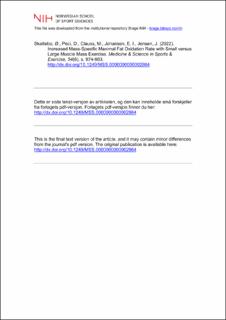| dc.contributor.author | Skattebo, Øyvind | |
| dc.contributor.author | Peci, Dafina | |
| dc.contributor.author | Clauss, Matthieu | |
| dc.contributor.author | Johansen, Egil Ivar | |
| dc.contributor.author | Jensen, Jørgen | |
| dc.date.accessioned | 2023-06-23T12:02:54Z | |
| dc.date.available | 2023-06-23T12:02:54Z | |
| dc.date.created | 2022-01-28T12:51:13Z | |
| dc.date.issued | 2022 | |
| dc.identifier.citation | Medicine & Science in Sports & Exercise. 2022, 54(6), 974-983. | en_US |
| dc.identifier.issn | 0195-9131 | |
| dc.identifier.uri | https://hdl.handle.net/11250/3072915 | |
| dc.description | I Brage finner du siste tekst-versjon av artikkelen, og den kan inneholde ubetydelige forskjeller fra forlagets pdf-versjon. Forlagets pdf-versjon finner du på journals.lww.com / In Brage you'll find the final text version of the article, and it may contain insignificant differences from the journal's pdf version. The original publication is available at journals.lww.com | en_US |
| dc.description.abstract | Introduction: Skeletal muscle perfusion and oxygen (O2) delivery are restricted during whole-body exercise due to a limited cardiac output (Q[Combining Dot Above]). This study investigated the role of reducing central limitations to exercise on the maximal fat oxidation rate (MFO) by comparing mass-specific MFO (per kg active lean mass) during one-legged (1 L) and two-legged (2 L) cycling. We hypothesized that the mass-specific MFO would be higher during 1 L- than 2 L cycling. Methods: Twelve male subjects (V[Combining Dot Above]O2peak: 59.3 ± 8.4 mL·kg-1·min-1; mean ± SD) performed step-incremental 2 L- (30-80% of V[Combining Dot Above]O2peak) and 1 L (50% of 2 L power output, i.e., equal power output per leg) cycling (counterbalanced) while steady-state pulmonary gas exchanges, Q[Combining Dot Above] (pulse-contour analysis), and skeletal muscle (vastus lateralis) oxygenation (near-infrared spectroscopy) were determined. MFO and the associated power output (FatMax) were calculated from pulmonary gas exchanges and stoichiometric equations. A counterweight (10.9 kg) was added to the contralateral pedal arm during 1 L cycling. Leg lean mass was determined by DEXA. Results: The absolute MFO was 24% lower (0.31 ± 0.12 vs 0.44 ± 0.20 g·min-1; P = 0.018) while mass-specific MFO was 52% higher (28 ± 11 vs 20 ± 10 mg·min-1·kg-1; P = 0.009) during 1 L- than 2 L cycling. FatMax was similar expressed as power output per leg (60 ± 28 vs 58 ± 22 W; P = 0.649). Q· increased more from rest to exercise during 1 L- than 2 L cycling when expressed per active leg (ANOVA main effect: P = 0.003). The tissue oxygenation index and Δ[deoxy(Hb + Mb)] were not different between exercise modes (ANOVA main effects: P ≥ 0.587), indicating similar skeletal muscle fractional O2 extraction. Conclusions: Mass-specific MFO is increased by exercising a small muscle mass, potentially explained by increased perfusion and more favorable conditions for O2 delivery than during whole-body exercise. | en_US |
| dc.description.abstract | Increased Mass-Specific Maximal Fat Oxidation Rate with Small versus Large Muscle Mass Exercise | en_US |
| dc.language.iso | eng | en_US |
| dc.subject | fatmax | en_US |
| dc.subject | maximal oxygen uptake | en_US |
| dc.subject | metabolism | en_US |
| dc.subject | one-legged cycling | en_US |
| dc.subject | single leg | en_US |
| dc.subject | substrate | en_US |
| dc.title | Increased Mass-Specific Maximal Fat Oxidation Rate with Small versus Large Muscle Mass Exercise | en_US |
| dc.title.alternative | Increased Mass-Specific Maximal Fat Oxidation Rate with Small versus Large Muscle Mass Exercise | en_US |
| dc.type | Peer reviewed | en_US |
| dc.type | Journal article | en_US |
| dc.description.version | acceptedVersion | en_US |
| dc.source.pagenumber | 974-983 | en_US |
| dc.source.volume | 54 | en_US |
| dc.source.journal | Medicine & Science in Sports & Exercise | en_US |
| dc.source.issue | 6 | en_US |
| dc.identifier.doi | 10.1249/MSS.0000000000002864 | |
| dc.identifier.cristin | 1992349 | |
| dc.description.localcode | Institutt for fysisk prestasjonsevne / Department of Physical Performance | en_US |
| cristin.ispublished | true | |
| cristin.fulltext | postprint | |
| cristin.qualitycode | 2 | |
